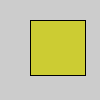| Name | & (bitwise AND) |
||||
|---|---|---|---|---|---|
| Examples |

a = 207 # In binary: 11001111 b = 61 # In binary: 00111101 c = a & b # In binary: 00001101 print(c) # Prints "13", the decimal equivalent to 00001101 
argb = color(204, 204, 51, 255) # The sytax "& 0xFF" compares the binary # representation of the two values and # makes all but the last 8 bits into a 0. # "0xFF" is 00000000000000000000000011111111 a = argb >> 24 & 0xFF r = argb >> 16 & 0xFF g = argb >> 8 & 0xFF b = argb & 0xFF fill(r, g, b, a) rect(30, 20, 55, 55) | ||||
| Description |
Compares each corresponding bit in the binary representation of the values. For each comparison two 1's yield 1, 1 and 0 yield 0, and two 0's yield 0. This is easy to see when we look at the binary representation of numbers11010110 # 214 & 01011100 # 92 -------- 01010100 # 84 To see the binary representation of a number, use the binary() function with print(). |
||||
| Syntax | value & value2 | ||||
| Parameters |
| ||||
| Related |
| (bitwise OR) binary() |
Updated on Tue Feb 27 14:07:12 2024.
If you see any errors or have comments, please let us know.

This work is licensed under a Creative Commons Attribution-NonCommercial-ShareAlike 4.0 International License